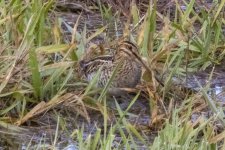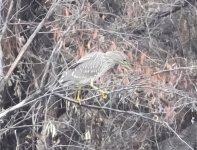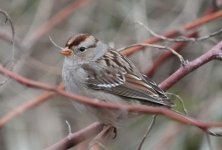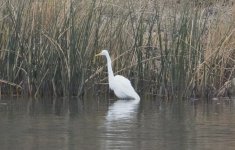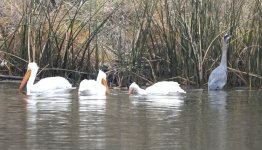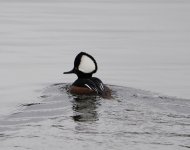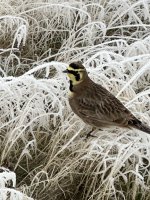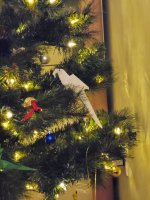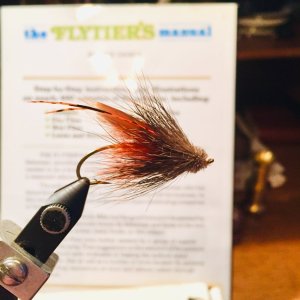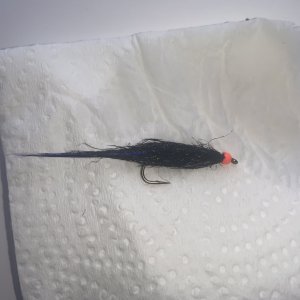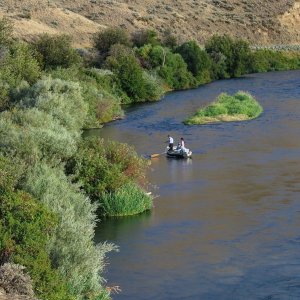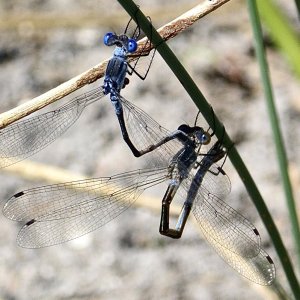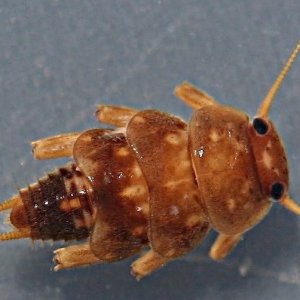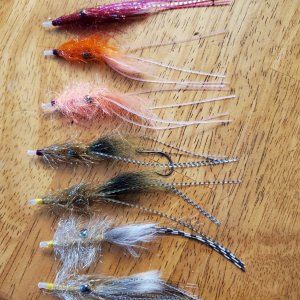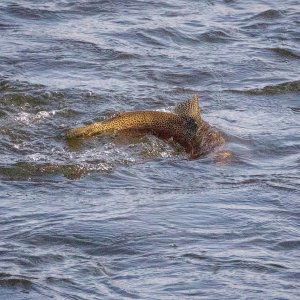Be careful to not be beneath them when they let loose. There is a huge amount of bird poo! Made that mistake once boat cruising near some houseboats. I could not wait to get home to wash my hair!
Navigation
Install the app
How to install the app on iOS
Follow along with the video below to see how to install our site as a web app on your home screen.
Note: This feature may not be available in some browsers.
More options
Style variation
You are using an out of date browser. It may not display this or other websites correctly.
You should upgrade or use an alternative browser.
You should upgrade or use an alternative browser.
Got any bird pics?
- Thread starter Wadin' Boot
- Start date
Jim F.
Still a Genuine Montana Fossil
Gulls are prone to dropping bunker busters as well.Be careful to not be beneath them when they let loose.
Successful snipe hunts. In common usage, a “snipe hunt” is an adventure to capture a mythical beast – a hopeless cause, a wild goose chase (though if you have ever encountered a pissed-off goose, you would want to give it a wide berth). But in fact, while “birds aren’t real”, Wilson’s snipes are, as pictures already in this thread have demonstrated. But snipes are well-camouflaged, stealthy, and fast, erratic fliers. About once a year, I catch a passing view of a snipe as one bombs overhead or as one disappears into the reeds.
But sometimes, you get lucky. And during a recent visit to Billie Frank Jr. Nisqually Wildlife Refuge, I lucked into a cooperative snipe. I wasn’t expecting to find a snipe. Who does? But I was watching a flock of feeding Northern pintail hens feeding at the transition from a freshwater marsh to grassy field. I noticed that one of these individuals was not like the others. In fact, there was snipe in the group, perhaps 30’ away from me.
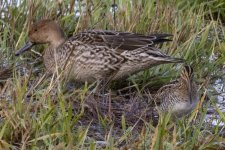
The pintails soon wandered off as they kept actively foraging, but the snipe remained. It did some hunting for food, some preening, and some relaxing.
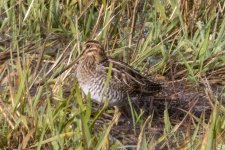
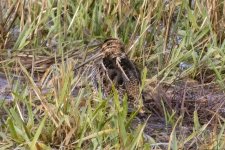
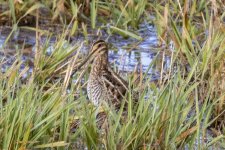
I came back an hour later and it hadn’t moved more than 10’.
My wife was excited for me that I had such as good view of the snipe, but unhappy that she wasn’t there as she was working. But the universe rewarded her (and me) a few days later when we visited Ridgefield National Wildlife Refuge. We didn’t see one or two snipes, but nine (!!!) individuals. These snipes were dozing, preening, and feeding along the edge of a peninsula at the edge of the refuge. [How many snipes can you see in this picture?]
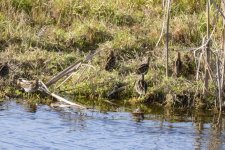
They weren’t as close to us as the singlet that I had seen a few days earlier, but they made up for it in numbers. That one group included more individuals than I have seen in total in 20 years.
Steve
But sometimes, you get lucky. And during a recent visit to Billie Frank Jr. Nisqually Wildlife Refuge, I lucked into a cooperative snipe. I wasn’t expecting to find a snipe. Who does? But I was watching a flock of feeding Northern pintail hens feeding at the transition from a freshwater marsh to grassy field. I noticed that one of these individuals was not like the others. In fact, there was snipe in the group, perhaps 30’ away from me.

The pintails soon wandered off as they kept actively foraging, but the snipe remained. It did some hunting for food, some preening, and some relaxing.



I came back an hour later and it hadn’t moved more than 10’.
My wife was excited for me that I had such as good view of the snipe, but unhappy that she wasn’t there as she was working. But the universe rewarded her (and me) a few days later when we visited Ridgefield National Wildlife Refuge. We didn’t see one or two snipes, but nine (!!!) individuals. These snipes were dozing, preening, and feeding along the edge of a peninsula at the edge of the refuge. [How many snipes can you see in this picture?]

They weren’t as close to us as the singlet that I had seen a few days earlier, but they made up for it in numbers. That one group included more individuals than I have seen in total in 20 years.
Steve
Attachments
I watched a snipe do a funky boogie dance, once.Successful snipe hunts. In common usage, a “snipe hunt” is an adventure to capture a mythical beast – a hopeless cause, a wild goose chase (though if you have ever encountered a pissed-off goose, you would want to give it a wide berth). But in fact, while “birds aren’t real”, Wilson’s snipes are, as pictures already in this thread have demonstrated. But snipes are well-camouflaged, stealthy, and fast, erratic fliers. About once a year, I catch a passing view of a snipe as one bombs overhead or as one disappears into the reeds.
But sometimes, you get lucky. And during a recent visit to Billie Frank Jr. Nisqually Wildlife Refuge, I lucked into a cooperative snipe. I wasn’t expecting to find a snipe. Who does? But I was watching a flock of feeding Northern pintail hens feeding at the transition from a freshwater marsh to grassy field. I noticed that one of these individuals was not like the others. In fact, there was snipe in the group, perhaps 30’ away from me.
View attachment 92495
The pintails soon wandered off as they kept actively foraging, but the snipe remained. It did some hunting for food, some preening, and some relaxing.
View attachment 92496
View attachment 92497
View attachment 92499
I came back an hour later and it hadn’t moved more than 10’.
My wife was excited for me that I had such as good view of the snipe, but unhappy that she wasn’t there as she was working. But the universe rewarded her (and me) a few days later when we visited Ridgefield National Wildlife Refuge. We didn’t see one or two snipes, but nine (!!!) individuals. These snipes were dozing, preening, and feeding along the edge of a peninsula at the edge of the refuge. [How many snipes can you see in this picture?]
View attachment 92500
They weren’t as close to us as the singlet that I had seen a few days earlier, but they made up for it in numbers. That one group included more individuals than I have seen in total in 20 years.
Steve
Actually, it was a woodcock now that I think of it.I watched a snipe do a funky boogie dance, once.
Cabezon - thanks, again, for some great pictures and commentary.
We’ve had a leucistic Somg Sparrow show up at our feeder every year for about five years now. I don’t know if this is the same one, but it showed up again yesterday and I was able to get a couple of pictures of it along with the Towhee.
Does anyone know how long these birds live in the wild? I’d like to think that it’s the same one.
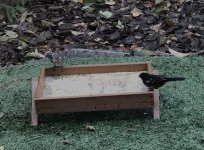
Does anyone know how long these birds live in the wild? I’d like to think that it’s the same one.

Cornell birds showed one is Colorado that was 11+ years old when recaptured. Kind of surprises me that they can live that long.
Almost didn't spot the song sparrow since it blended in with the background
Almost didn't spot the song sparrow since it blended in with the background
Thanks for the info'. I wouldn't have guessed they'd live that long either!
So, maybe it is the same bird!
So, maybe it is the same bird!
Leucistic birds are not all that common, as you know. We have had a leucistic crow in the area and had a leucistic black-capped chickadee at the feeder in the past.
That is an immature black-crowned night heron. The sparrow is a juvenile white-crowned; see the yellow-orange bill. A golden-crowned juvenile would have a gray bill.Variety. Most are long shots with a Sony A7RV and are heavily cropped. I can't tell if the grainy shot is a Bittern or an immature Night Heron. Any thoughts on which it is? Not sure about the Sparrow either.
View attachment 92922View attachment 92923
Steve
I stand corrected on the sparrow! Thanks to Steve and Jim!Nice images = thanks for sharing! I'll go with an immature black crowned night heron for the top image. I'm not great with sparrows but I think that's a female golden crowned sparrow.
Bass-O-Matic
Life of the Party
Not my box. That one is one Hayward Hill Rd off Highway 10 across from where the Thorp Highway ends above the Green Bridge on the Yakima. I have a ton more bluebird shots so I'll dig up a couple more.Nice mountain blue bird. Your nest box?
Gotta love those birds. Although, there are very few bird I loathe.
With that particular shot I swear the bird was listening to the "conversation" going on inside the house. There were babies and mom inside at the time.
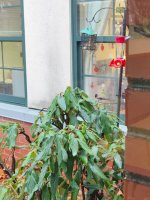
Dark eyed Junco. A population of them has colonized the UCSD campus and drastically change life histories and have been subject to rapid evolution. The one pictured is from the courtyard of my school. We use the phenomenon of UCSD juncos to teach our biology students about natural selection and how it is impacted by human activity. They are always quite surprised to understand that behaviors like boldness are inherited traits (controlled by corticosterone production) and thus acted on by environmental pressures. More about the UCSD juncos: https://juncoproject.org/

